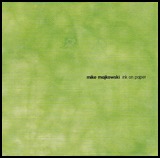Mike Majkowski
夢枯記035 Mike Majkowski | Ink on Paper
07 04. 14 14:45
contrabass solo/cd/creativesources/2009
https://sites.google.com/site/mikemajkowski/

【Yumegareki 035】
What impressed me most was the forth one, “ink on paper,” the title music. The sound image of ink dropping down on a paper came rushing toward me one after another. I assume the many spots of blurry light green color on the jacket represent the ink. The act of music is a creative value manifested the image of ink’s motion in sound as Mr. Mike demonstrates in his work. It is also a way of expressing our world view. But I am more interested in how inaction can be incorporated into the action.
Variance and repetition of the endless tone of the falling inks sound like an everlasting movement possessed by each tiny piece of sound. They lead to the burgeon sensation that nests and noises in the universe really exist in every part of the world. The endless action is supported by the inaction that runs through the universe. Also, the action might create inaction. Finally, when the sound suddenly stopped, I felt my sense overlapped with Mr. Mike’s. It was an interesting experience for me. There may be countless ways of cutting music into pieces, but my body felt an encounter at the final point where Mr. Mike’s action and inaction coincided. The moment when the sound stopped in “ink on paper,” I might have felt inaction of the sound itself.
Zeami is the founder of Noh, the oldest Japanese theatrical arts. In his book, Zeami talked about three key components of performance, “hi-niku-kotsu (skin-meat-bone),” where “hi” stands for the performance appreciated by the eyes of the audience, “niku” stands for the process of performance, and “kotsu” stands for the deep layer of the heart where the process is created. He said that the fusion of them is the ideal form of performance. I wonder if inaction comes about only when the performers have gone through ascetic practices for years and finally reached the point exceeding the action. Zeami further pursued a concept of “hie.” “hie” is the ultimate form of “en (refined beauty).” Zeami explored a possibility to bring Noh to the level of “hie” by transforming “shin (mind)” to “tai (body).” It seems that the concept of “hie” is the extreme form of inaction.
Likewise, music performs by itself in the process of inaction in a hidden place deep inside, in addition to the one expressed in action. I wonder if music is an experience of observing and listening to the sound of a burgeoning life which simultaneously possesses the natural oldness at the very moment of its birth. The action of inaction may be a seeping movement of action in a form of inaction, just like a drop of ink, seeping into the paper and expanding the scope and blurring the tiny area, not just a piece of music expressing the variance and repetition of the drops of ink.
最近はつまるところは身体疲労のせいか、何を聴いても僕自身の課題をそのどこかに見いださずにはいられないようで困ったものである。前回(034)から無音という出来事を音にどのように所作したらよいかと、次第に思いはじめてきて結局たどりつくのは、作為とは何か、無為であるとはどういうことか、ということである。昨年夏に郡上八幡でみた能の様々な所作のことが記憶から蘇生してイメージされてきた。ふと思い出したのは、以前、能狂言、謡曲の研究家である小山弘志さんを全く偶然だったのであるが、何度か診察させていただいたことがある。どういう方か全く存じ上げていなかったのだが、話のなかで小山さんは「ピンク色の塗り薬」とおっしゃらずに、「ももいろをした膏薬」と表現されていた。単にご高齢の方だからというわけでもなく普段は聞き慣れない響きで、そのときの言葉の発音が、からだのどこかに住み着くように気になって記憶に残っていた。言葉にどこか色艶があったのだと思う。数年前、新聞で他界されたという記事が…もっと読む... Read more...
https://sites.google.com/site/mikemajkowski/

【Yumegareki 035】
What impressed me most was the forth one, “ink on paper,” the title music. The sound image of ink dropping down on a paper came rushing toward me one after another. I assume the many spots of blurry light green color on the jacket represent the ink. The act of music is a creative value manifested the image of ink’s motion in sound as Mr. Mike demonstrates in his work. It is also a way of expressing our world view. But I am more interested in how inaction can be incorporated into the action.
Variance and repetition of the endless tone of the falling inks sound like an everlasting movement possessed by each tiny piece of sound. They lead to the burgeon sensation that nests and noises in the universe really exist in every part of the world. The endless action is supported by the inaction that runs through the universe. Also, the action might create inaction. Finally, when the sound suddenly stopped, I felt my sense overlapped with Mr. Mike’s. It was an interesting experience for me. There may be countless ways of cutting music into pieces, but my body felt an encounter at the final point where Mr. Mike’s action and inaction coincided. The moment when the sound stopped in “ink on paper,” I might have felt inaction of the sound itself.
Zeami is the founder of Noh, the oldest Japanese theatrical arts. In his book, Zeami talked about three key components of performance, “hi-niku-kotsu (skin-meat-bone),” where “hi” stands for the performance appreciated by the eyes of the audience, “niku” stands for the process of performance, and “kotsu” stands for the deep layer of the heart where the process is created. He said that the fusion of them is the ideal form of performance. I wonder if inaction comes about only when the performers have gone through ascetic practices for years and finally reached the point exceeding the action. Zeami further pursued a concept of “hie.” “hie” is the ultimate form of “en (refined beauty).” Zeami explored a possibility to bring Noh to the level of “hie” by transforming “shin (mind)” to “tai (body).” It seems that the concept of “hie” is the extreme form of inaction.
Likewise, music performs by itself in the process of inaction in a hidden place deep inside, in addition to the one expressed in action. I wonder if music is an experience of observing and listening to the sound of a burgeoning life which simultaneously possesses the natural oldness at the very moment of its birth. The action of inaction may be a seeping movement of action in a form of inaction, just like a drop of ink, seeping into the paper and expanding the scope and blurring the tiny area, not just a piece of music expressing the variance and repetition of the drops of ink.
最近はつまるところは身体疲労のせいか、何を聴いても僕自身の課題をそのどこかに見いださずにはいられないようで困ったものである。前回(034)から無音という出来事を音にどのように所作したらよいかと、次第に思いはじめてきて結局たどりつくのは、作為とは何か、無為であるとはどういうことか、ということである。昨年夏に郡上八幡でみた能の様々な所作のことが記憶から蘇生してイメージされてきた。ふと思い出したのは、以前、能狂言、謡曲の研究家である小山弘志さんを全く偶然だったのであるが、何度か診察させていただいたことがある。どういう方か全く存じ上げていなかったのだが、話のなかで小山さんは「ピンク色の塗り薬」とおっしゃらずに、「ももいろをした膏薬」と表現されていた。単にご高齢の方だからというわけでもなく普段は聞き慣れない響きで、そのときの言葉の発音が、からだのどこかに住み着くように気になって記憶に残っていた。言葉にどこか色艶があったのだと思う。数年前、新聞で他界されたという記事が…もっと読む... Read more...

